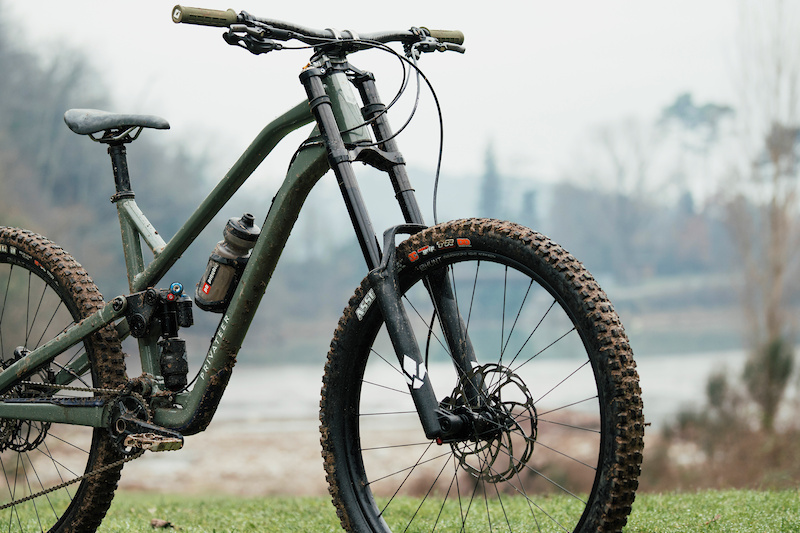Formula haven’t started from scratch with this project. The lower legs, air spring, axle and damper are all virtually identical to the single-crown Selva S fork. They’ve just extended the damper shaft and fitted a spacer in the air side to make it work with the longer upper tubes. So, unlike a downhill fork, there’s a 15 mm axle, tapered steerer and 43 mm offset, making it a drop-in replacement for a single crown enduro fork.
• Intended use: enduro, e-bike, park, freeride
• Travel: 170-180mm (internally adjustable)
• Wheel size/offset: 29″/43mm
• Adjustments: Positive air pressure, Compression, Rebound, Interchangeable CTS compression valves, Neopos volume spacers
• 35mm stanchions
• Brake mount: 180mm
• Weight: 2,456 grams (actual)
• MSRP: TBC
• rideformula.com
The main advantages promised are improved fore-aft stiffness, less chance of crown creaking, potentially more travel for a given axle to crown length and adjustable axle to crown length, which can be used to alter a bike’s geometry.
Back in 2021, Formula claimed their early prototype was 2,300 g with a target weight of 2,270 g. However, the fork they sent me to test weighs 2,456 g with fork bumpers – 93 g more than a Fox 38. Formula say they strengthened the stanchions to prevent ham-fisted mechanics from damaging them while tightening the crowns. The other obvious downside is the steering lock, which makes it hard to get around very tight corners.
To see how it stacks up, Formula invited me to their factory in Prato, Italy to test it on their local rocky test tracks, To their great credit, they asked me to bring my favourite single-crown fork to benchmark against. They also let me take it home to test on familiar trails.
Technology & Features
Like the Selva S, the Belva uses a coil negative spring below the piston with an adjustable air chamber above. The negative spring (which counteracts the force from the positive air pressure at the start of the travel, making it easier to enter into the travel) is composed of three coil springs, which together get stiffer as you move towards full extension. This helps prevent top-out, but the negative spring is non-adjustable, so the shape of the spring curve and the available travel will depend on the rider’s weight and therefore air pressure. With the minimum recommended air pressure (50 psi), I measured 175 mm usable travel and a buttery smooth beginning stroke; with 75 psi, the travel increased to 184 mm and the beginning stroke was noticeably stiffer (even relative to the rest of the travel), and at the maximum of 85 psi, it tops out harshly like a coil spring with way too much preload.
Formula makes a Selva R fork with a dual air spring (both positive and negative chambers are adjustable to suit different rider weights) but that spring is not available on the Belva.
The Belva uses Formula’s Neopos spacers, which shrink with increasing air pressure, thereby boosting mid-stroke support relative to the end-stroke, so it’s easier to access full travel. In other words, they make the spring force more linear throughout the travel.
On the damper side, the interchangeable CTS valves make it possible to radically alter the compression damping characteristics, from highly digressive (lots of low-speed damping) to progressive (lots of high-speed damping) to linear (somewhere in between). This is in addition to a low-speed compression dial that adjusts a parallel oil flow path and makes a considerable difference to the overall damping behaviour in its own right, without the need to change the valve. There’s a lockout lever too (mostly to make it easier to change the CTS valves) and a rebound dial. There are no bleed buttons.
The air shaft connects to the air spring piston – which slides inside the upper tube – via a ball joint. Formula says this reduces side-loading and therefore friction in the piston while the fork is bending due to a heavy impact or braking (all forks bend back and forth during normal riding). Formula call this IFT (Internal Floating Technology).
The Test
With the help of Formula’s engineers (and even the CEO), we got the fork set up on my Privateer 161 long-term test bike, ensuring identical axle-to-crown and bar height measurements as the stock Fox 38. We then shuttled four laps of a rocky three-minute track, tweaking the setup until I was happy with it. Then I swapped to the Fox 38 with my regular settings for two full runs, before swapping back for another two on the Belva. This allowed me to feel the differences between the forks in both directions.
Setup
Based on the chart printed on the lower leg I started with 70 psi, but found this too soft so stepped up to 75 psi. Any more than this and the touchdown feel at the start of the stroke became too firm. I added a second Neopos spacer and wound on compression damping to around the halfway mark to add support without adding more air. I ran the rebound fully open. To match the axle to crown height of the 170 mm Fox 38 (590 mm), I ran it with the crowns at the full height and with the spring at 180 mm travel – the Privateer test bike’s massive 145 mm head tube reduces the scope to extend the axle to crown length. It wasn’t my intention to compare the 170 mm Fox 38 to the Belva set to 180 mm, but if the fork length is the same you may as well make use of more travel.
I compared the Belva to the Fox 38 that came with the Privateer. I’ve done a load of winner-stays-on comparison tests over the years and the Fox 38 is still the benchmark in my book. I don’t think the black Performance Elite version performs differently from the golden Factory version. My settings are: 100 psi, 1 spacer, HSR 1 from open, LSR 5 from open, LSC 4 from open, and HSC 4 from open. (Yes, I know it’s conventional to count clicks from closed but when you’re closer to open it’s easier this way.)
Performance
Formula has done a good job with friction reduction and bushing sizing. The Belva bobs when pedalling smoothly and moves for the smallest bumps in the trail. The spring is frustratingly firm at the very start of the travel, making it feel like breaking through the surface of a crème brûlée when the wheel touches down, before sinking into the silky travel thereafter. Most of the time, the fork is in that 10-100% travel range and here it feels superb. Everything from small sticks to big boulders are dealt with in a smooth and controlled way.
Compared to the Fox 38, the Belva was more damped and less lively. This is probably because, once you get past that initial sticking point at the start of the travel, the Belva has a softer spring rate in the rest of the stroke. I also needed more compression damping on the Belva to make up for the softer mid-stroke, and the rebound wasn’t super fast even fully open. The result was a calmer feel, especially in the big, low-frequency rock gardens in Italy.
The Fox 38 felt more predictable in a sense due to its relatively consistent spring rate throughout the stroke, so the fork stayed closer to sag with less pitching. The firmer spring and lighter damping made for a livelier ride in the big chunks, but not to the point that it was hard to manage. It was more supportive and quicker to recover, making it feel more eager and less lazy. But the downside is a less soothing feel through the rocks, especially toward the end of the descent.
On the biggest frontal impacts, I did find the Belva more composed, which could be down to the additional fore-aft stiffness or the different spring and damper characteristics. Perhaps Formula’s IFT internals help here too.
Back home in the Tweed Valley, I was less impressed. In colder temperatures the rebound was a little too slow for my liking, making the fork feel lethargic and slow to respond over high-frequency roots. While I never found the steering lock to be an issue while descending, it can be annoying during slow-speed climbing, when doing a U-turn on the wrong trail, or when track-standing. I did find it useful to play around with the fork length for steeper or flatter trails, though.

Laura Adams is a tech enthusiast residing in the UK. Her articles cover the latest technological innovations, from AI to consumer gadgets, providing readers with a glimpse into the future of technology.








